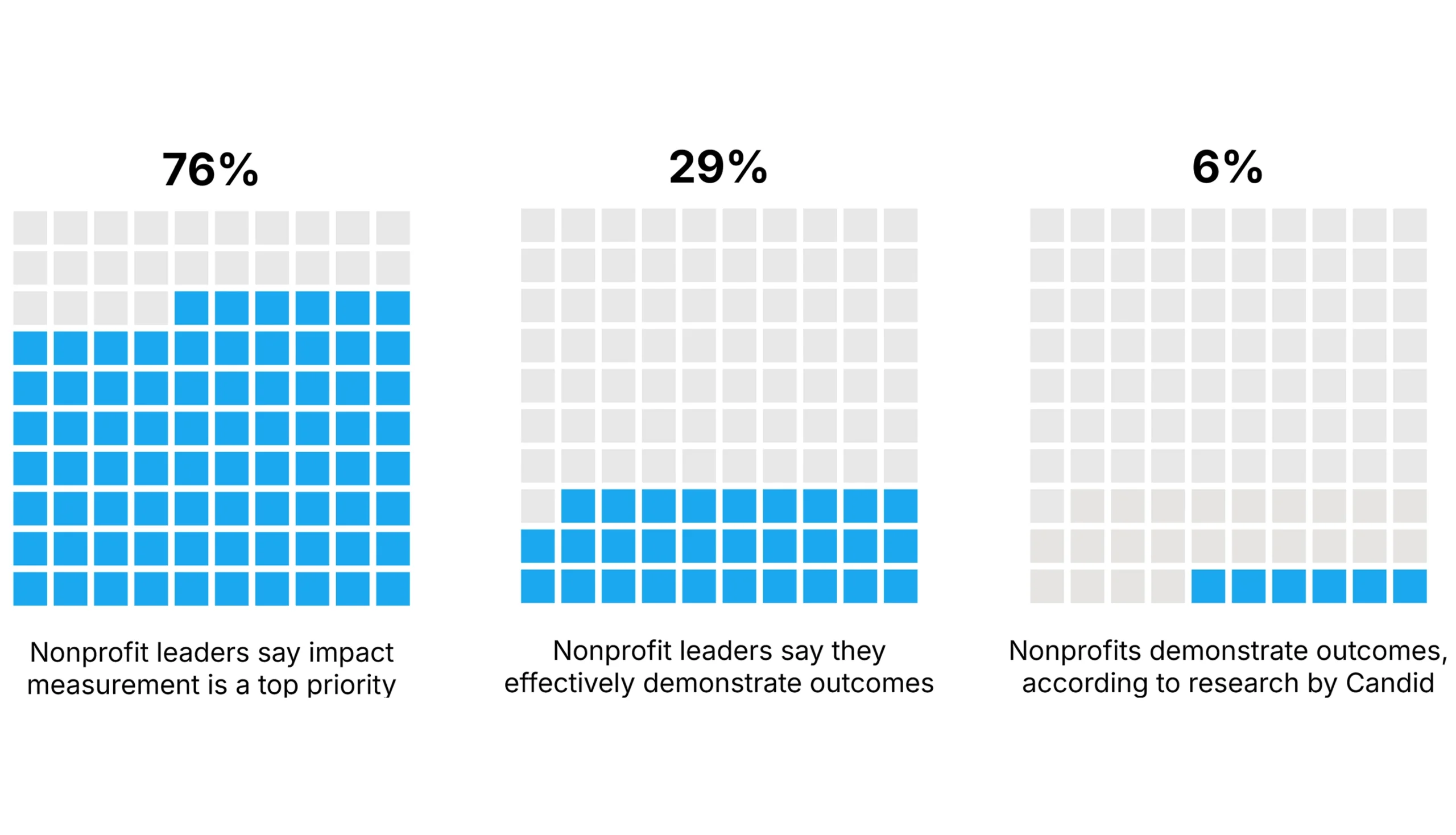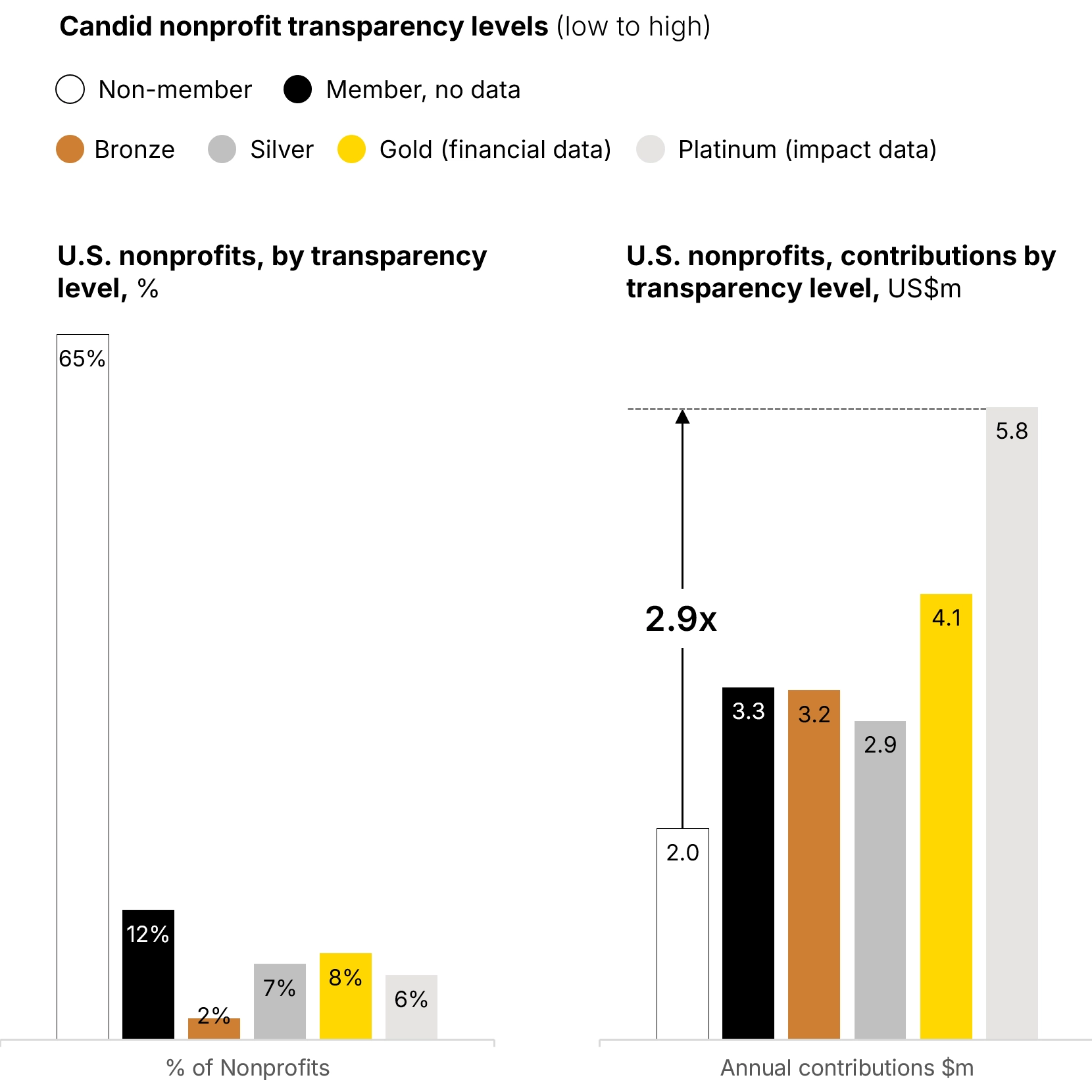The 3x funding advantage: how impact metrics transform nonprofit growth
What if your organization could triple its funding without hiring additional fundraising staff or launching expensive campaigns? That's not hypothetical. It's exactly what the latest research reveals about organizations that demonstrate quantifiable social outcomes compared to those with no transparency engagement.
The data exposes a striking sector-wide paradox. While 76% of nonprofit leaders say impact measurement is a top priority, research shows that only 6% are actually doing so. This 70-percentage-point execution gap represents one of the most significant strategic blind spots in the nonprofit sector today.

Sources: 76% priority, 29% effective demonstration: Oracle NetSuite's "Connecting Dollars to Outcomes" survey of 353 nonprofit executives figure). 6% Candid figure: Candid's 2025 study "Do Nonprofits With a Candid Seal of Transparency Raise More Funds?" analyzing 148,786 nonprofits (6% represents the percentage of nonprofits holding Platinum Seals of Transparency, which require demonstration of strategy, goals, and impact metrics).
Major U.S. rating platforms like Candid (formerly GuideStar) and Charity Navigator have evolved to reward organizations that share quantifiable outcome data. Candid's highest "Platinum Seal" requires nonprofits to publicly report specific metrics tracking progress toward their strategic goals, yet only 6% of organizations achieve this level. This creates an enormous competitive gap that forward-thinking organizations are already exploiting.
The evidence is compelling across the nonprofit rating ecosystem. The 2025 Candid study of 148,786 U.S. non-profits reveals that nonprofits earning Platinum Seals, which require sharing quantifiable impact metrics, receive an average of $5.8 million in annual contributions compared to $1.95 million for organizations with no transparency enhancement. The funding advantage escalates dramatically with each level of transparency commitment, creating a nearly 3x multiplier effect for organizations willing to demonstrate measurable outcomes.

Sources: Clerkin, C., Hollander, D., Sato, G., & Sahu, Y. (2025). Do nonprofits with a Candid Seal of Transparency raise more funds? [White paper]. Candid. doi.org/10.15868/socialsector.44977. Final sample of 148,786 nonprofits after data cleaning and targeted randomized downsampling. Organizations span all major nonprofit subsectors with representation from human services (37%), education (16%), health (14%), and other mission areas.
Similarly, Charity Navigator redesigned its entire methodology to prioritize "Impact & Results" alongside financial health, reflecting sector-wide consensus that demonstrating measurable outcomes drives superior funding performance. What emerges from this data is a clear competitive landscape where 94% of organizations are missing the funding advantage available to those who can quantify their social impact.
The Canadian context presents additional challenges, as there is no equivalent to Candid's transparency framework. While Charity Intelligence Canada measures financial efficiency and overhead ratios, it does not provide the same strategic, impact-focused approach that drives the funding advantage documented in U.S. markets.
The opportunity lies in collaborative strategy development that integrates measurement into organizational DNA rather than treating it as compliance theater. Organizations that view impact data as a learning tool for continuous improvement, not just funder reporting, create virtuous cycles where better measurement drives better programs, which attract better funding, enabling greater impact. In an increasingly evidence-driven philanthropic landscape, the question isn't whether to invest in impact measurement—it's whether you can afford not to.
About the author
Mark McCarvill is the Founder and Lead Facilitator at Mind Meeting Group, a strategy consulting firm based outside Vancouver, Canada. Mind Meeting Group helps business, government, and non-profit leaders align departments and mobilize teams through collaborative workshops that deliver execution-ready strategies.
